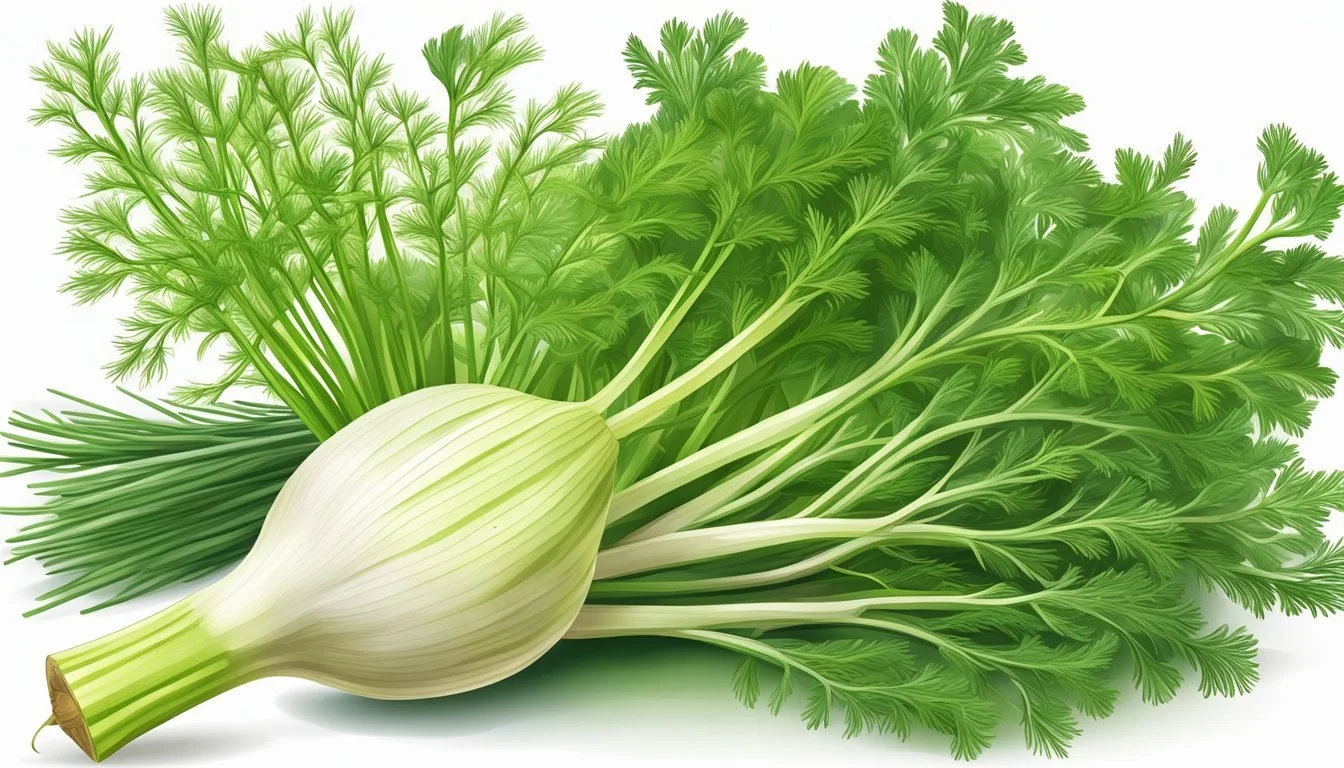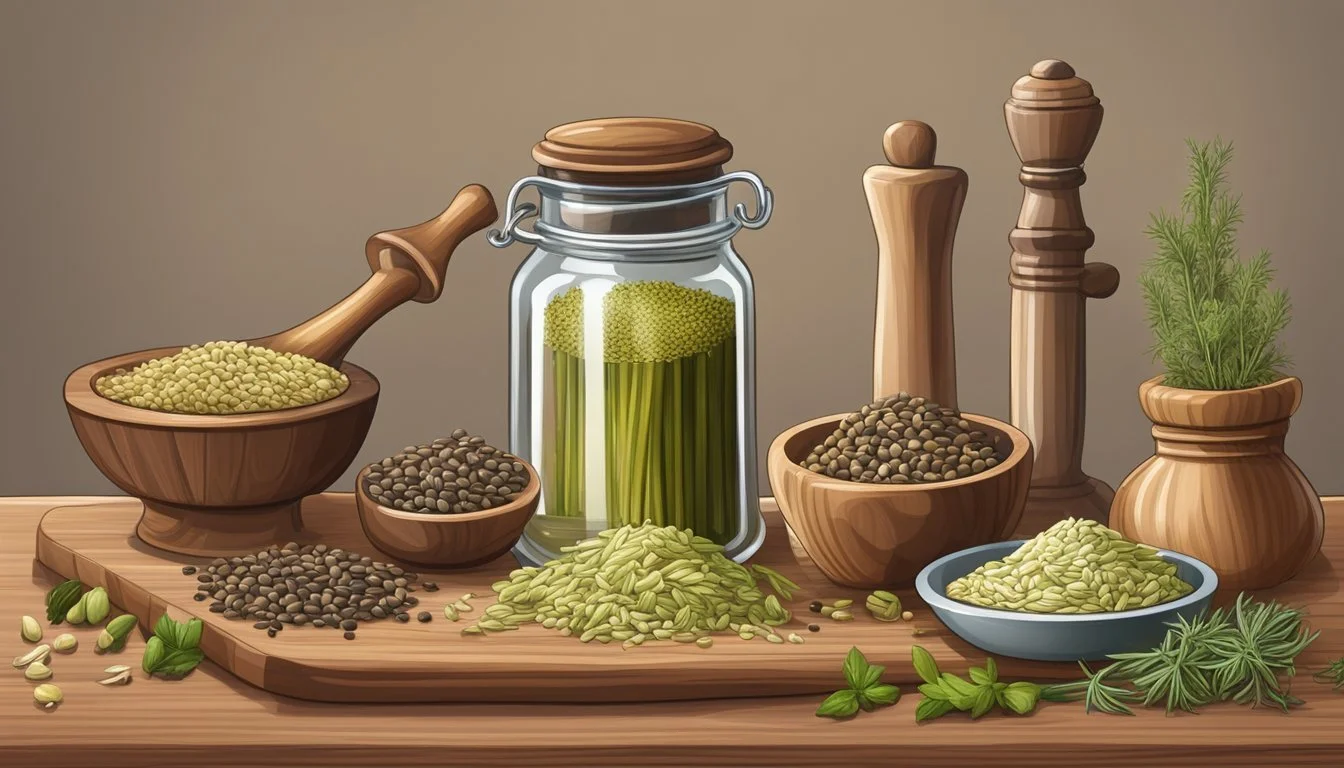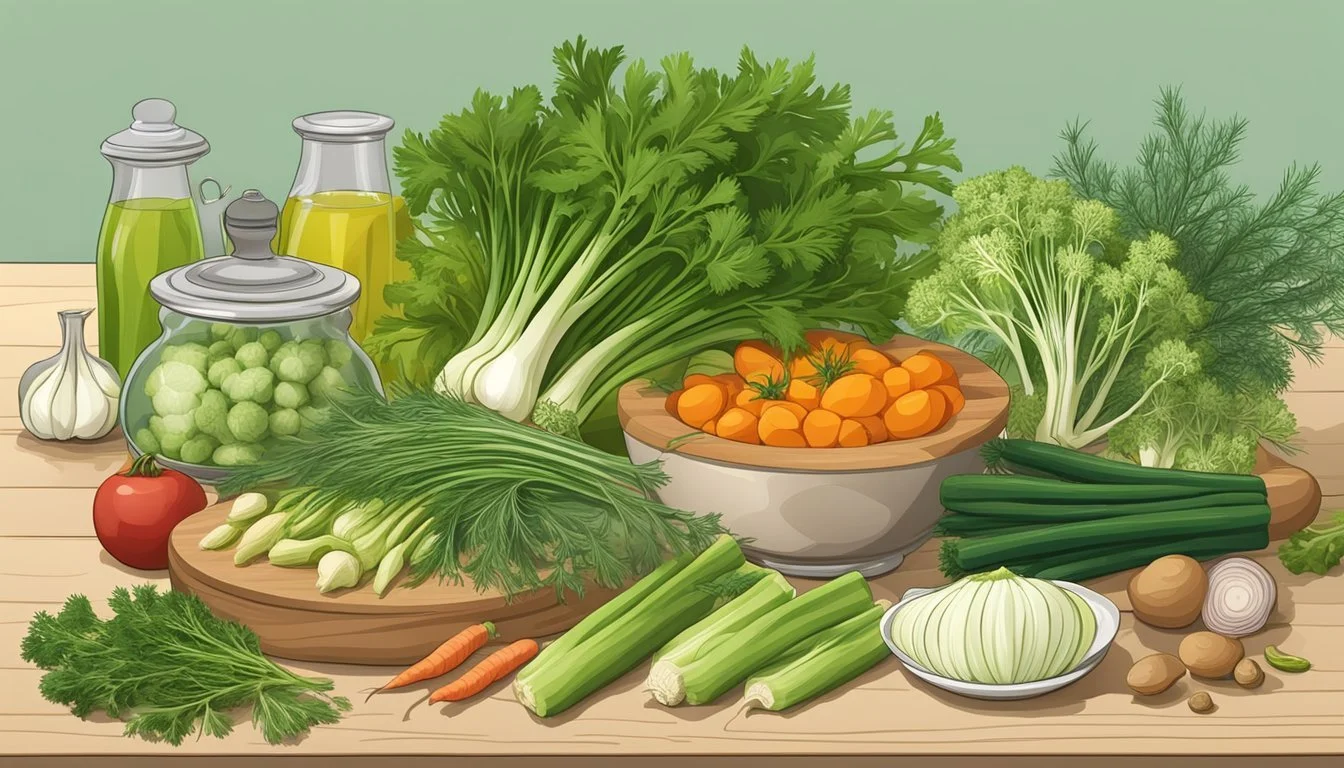Fennel Substitutes
The Best Alternatives for Your Recipes
When you're cooking and find yourself out of fennel, or simply need an alternative due to taste preferences, knowing the best substitutes can be a lifesaver. Fennel, with its unique licorice-like flavor, can be tricky to replace. Anise seed is a perfect swap for fennel seed, offering a similar licorice flavor. For fresh fennel, celery stands out as a comparable substitute due to its similar texture and crunch, making it ideal for salads and stir-fries.
Bok choy is another great option, especially if you need a raw ingredient for salads. It's crisp and refreshing, offering a different, but still enjoyable, taste and texture. Onions, though lacking the licorice note, can mimic the cooking behavior of fennel in soups and stews, while anise can be used to replicate the specific flavor profile of fennel seeds.
Leeks can also be considered, particularly for recipes focusing on texture rather than flavor. While their leaves are not typically palatable, the white and pale green parts can add volume and a mild taste to dishes, making them a versatile addition to your kitchen arsenal when fennel is not an option.
Understanding Fennel
Fennel is a versatile plant that adds a unique flavor to a variety of dishes. It consists of several parts, each with distinct culinary uses and nutritional benefits.
Fennel Characteristics
Fennel is known for its crunchy texture and mild anise-like flavor, often compared to licorice. The plant is composed of a bulb, stalks, and feathery fronds, all of which are edible. The bulb is typically white or pale green, creating a crisp base for many recipes. Stalks are more fibrous, suitable for adding depth to soups and stews. Fronds, resembling dill, provide a delicate flavor often used as a garnish or in salads.
Culinary Uses of Fennel
Fennel is an important ingredient in Mediterranean cuisine, prominent for its distinct but gentle flavor. The fennel bulb can be thinly sliced and eaten raw in salads or grated for coleslaws. It also caramelizes beautifully when roasted or sautéed, adding a rich flavor to dishes. Fennel seeds, with their stronger anise flavor, are commonly used in spice blends, sausages, and pickles. The leaves and fronds serve as aromatic herbs, complementing fish, pasta, and vegetable dishes.
Nutritional Profile of Fennel
Fennel is not only flavorful but also highly nutritious. A 100-gram serving of fresh fennel bulb contains roughly 31 calories, making it an excellent low-calorie option. It is a good source of fiber, vitamin C, potassium, and manganese. Additionally, fennel provides small amounts of iron, calcium, and magnesium. Fennel seeds are concentrated in nutrients, including essential fatty acids and antioxidants, contributing to digestive health and reducing inflammation. This nutrient-rich profile makes fennel a valuable addition to a balanced diet.
Why Substitute Fennel?
Substituting fennel becomes necessary for various reasons, including personal taste preferences, dietary restrictions, and availability issues. Addressing each of these aspects ensures that you can effectively replace fennel without compromising the quality or flavor of your dish.
Taste Preferences
Fennel is known for its distinct licorice-like flavor, which is not universally enjoyed. Some people may find it too overpowering or simply not to their taste. Common substitutes like celery or onion provide a similar texture without the bold licorice note.
Dill can also be used if a milder herbal flavor is preferred. A pinch of cumin may replicate some of the unique tastes found in fennel, without being as overpowering.
Dietary Restrictions
Allergies or specific dietary restrictions also necessitate substituting fennel. Some individuals may be allergic to certain compounds found in fennel. In such cases, choosing an alternative ingredient is essential to avoid adverse reactions.
Leeks or celery are excellent substitutes that can offer similar structural qualities. These alternatives are generally well-tolerated and can be used safely in recipes requiring a bulbous vegetable with a crunchy texture.
Availability Issues
Fennel may not always be readily available in all regions or grocery stores. Seasonal availability or supply chain issues can make it challenging to find. This makes it practical to have reliable substitutes on hand.
Celery and onion are common kitchen staples and can easily be used in place of fennel. Caraway or cumin seeds can also be excellent substitutes when fennel seeds are unavailable, ensuring the dish maintains its intended flavor profile.
Using these substitutions creatively can help maintain the integrity of dishes when fennel is not an option.
Fennel Seed Substitutes
When fennel seeds are unavailable, other spices can offer a similar flavor or enhance your dish in a complementary way. This section explores anise seed, caraway seeds, and cumin seeds as effective replacements for fennel seeds.
Anise Seed as a Substitute
Anise seed is one of the closest substitutes for fennel seeds due to its similar licorice-like flavor. Both anise seed and fennel seed share the compound anethole, which is responsible for their sweet, aromatic flavor.
Use anise seeds in a 1:1 ratio when substituting for fennel seeds. They are ideal for use in sweet dishes, pastries, and liquors. Anise seeds are smaller but pack a robust flavor.
Toasting anise seeds before use can bring out their best qualities, enhancing the overall flavor of the dish. Ground anise seed can also be used if a finer consistency is needed.
Caraway Seeds for Baking
Caraway seeds provide a warm, slightly nutty flavor that is different from but complementary to fennel’s profile. They are commonly used in European baking, especially in dishes like rye bread and sauerkraut.
Caraway seeds are a good fennel seed substitute in savory recipes due to their earthy notes. Replace fennel seeds with caraway seeds in a 1:1 ratio.
These seeds also contain carvone, which gives them a distinct aroma that can add a unique twist to your recipes. Toasting caraway seeds lightly can help accentuate their nuttiness and enhance the dish’s flavor.
Cumin Seeds for Warmth
Cumin seeds bring a warm, earthy tone that can complement or replace the sweetness of fennel seeds in savory dishes. They are particularly useful in Middle Eastern, Indian, and Mexican cuisines.
When substituting cumin seeds for fennel seeds, use them in a 1:1 ratio. Their intense flavor can enhance soups, stews, and spice blends.
Grinding cumin seeds can release more aromatic oils, making them even more potent. This makes it a versatile alternative in both whole and ground forms, fitting a variety of culinary applications.
Fennel Bulb Alternatives
When you can't find fennel bulbs, several suitable substitutes can provide similar flavors and textures. Each of these alternatives brings unique attributes to your dishes, enhancing their culinary appeal.
Celery for Crunchiness
Celery is an excellent alternative to fennel bulbs due to its crisp texture and structure. Although it lacks the distinct anise flavor of fennel, it pairs well with many ingredients. The crunchiness of celery makes it a perfect addition to salads and stir-fries. It also retains its texture when cooked, offering a pleasant bite in soups and stews.
Celery's mild taste allows it to blend seamlessly into various dishes without overpowering other flavors. For a simple substitution, use celery stalks chopped to the desired size.
Onions for Versatility
Onions are versatile substitutes that can mimic the texture of cooked fennel bulbs. Yellow onions, in particular, caramelize well and develop a sweet, rich flavor over long cooking periods. Red onions add color and a slightly milder taste, while white onions offer a more pungent option.
Use onions in equal amounts to replace fennel bulbs in recipes. They work well in soups, stews, and roasted vegetable dishes. Onions can be sautéed, caramelized, or even eaten raw in salads for a vibrant touch.
Leeks for Mildness
Leeks are another good substitute for fennel bulbs, particularly in cooked dishes. They have a mild, slightly sweet flavor that resembles cooked fennel. The white and light green parts of leeks can be used in the same way as fennel bulbs.
Leeks are best for recipes where they will be cooked, such as soups, casseroles, and sautés. Their mildness makes them an excellent choice for those who find the taste of fennel too strong. When substituting, slice leeks thinly to match the texture of fennel bulbs.
These three substitutes - celery, onions, and leeks - provide varied flavors and textures, making them suitable for a wide range of recipes that call for fennel bulbs.
Herbal and Spice Substitutes
Using herbs and spices as substitutes for fennel offers a range of flavor profiles. Key alternatives include dill, parsley, and tarragon, each providing distinct yet complementary tastes.
Dill for a Delicate Touch
Dill serves as a versatile substitute, particularly in dishes where a milder, more nuanced flavor is desired. Its delicate and slightly sweet taste makes dill ideal for use in lighter recipes such as salads, soups, and seafood dishes. Fresh dill leaves can be finely chopped and added at the end of cooking to preserve their flavor.
Additionally, dill seeds offer a subtly different flavor, slightly more robust and suitable for pickling or incorporating into savory baked goods. Dill's unique profile pairs well with ingredients like cucumber and citrus, enhancing their natural flavors without overpowering them.
Parsley for Freshness
Parsley is one of the most accessible and widely used herbs, known for its bright and fresh flavor. It works well as a fennel substitute in a variety of dishes, from soups to salads. Parsley leaves have a slightly peppery taste, which can refresh and cleanse the palate.
When using parsley as a substitute, fresh parsley is preferable. It should be added towards the end of cooking or used raw to retain its vibrant color and flavor. Finely chopped parsley can elevate dishes such as tabbouleh, chimichurri, and gremolata, providing a zestful contrast to richer flavors.
Tarragon for Unique Flavor
Tarragon offers a unique licorice-like flavor, making it a strong alternative to fennel. Tarragon leaves are particularly potent, so it's advisable to use them sparingly. This herb pairs naturally with poultry, fish, and egg dishes. Its distinctive taste can also enhance sauces and dressings, adding a sophisticated note.
A good rule of thumb is to use about three-quarters of the amount of tarragon leaves in place of fennel to avoid overwhelming the dish. Tarragon’s affinity for vinegar also makes it ideal for homemade pickles and infused vinegars, introducing a nuanced depth of flavor.
Vegetable Substitutes in Cooking
When needing a substitute for key vegetables, certain ingredients can step in seamlessly without sacrificing flavor or texture. Here are some detailed options tailored to specific recipes.
Artichokes for Heartiness
Artichokes bring a hearty texture to dishes, ideal for recipes requiring bulk without overwhelming flavors. Fresh or canned, their mild taste complements various ingredients.
In warm salads, artichokes add a meaty bite. Marinated artichokes can enhance pasta dishes, pairing well with creamy or tomato-based sauces. When substituting, keep in mind the slight tang from marination (if applicable) which may alter the dish’s flavor profile mildly. For casseroles or stuffings, quartered artichokes can replace ingredients like mushrooms or potatoes, adding a unique twist.
Bok Choy in Asian Recipes
Bok choy is a versatile leafy vegetable, perfect for Asian-inspired dishes. Its crisp texture and mild taste make it an excellent substitute in stir-fries, soups, and salads.
For stir-fries, substitute bok choy for vegetables such as napa cabbage or spinach. Its crunchy stalks hold up well to high heat, maintaining a satisfying texture throughout cooking. In soups, bok choy adds both leaf and stalk texture, complementing broths and noodles. When used raw, it boosts salads with fresh, crisp elements. Slice the stalks thinly for a texture similar to fennel, enhancing crunch without altering the flavor profile drastically.
Liquor-Based Fennel Alternatives
Liquor-based fennel substitutes provide unique flavors that can be used to mimic the distinct anise-like taste of fennel. Pernod and absinthe are two notable options, each offering specific characteristics to consider.
Pernod for Anise Aroma
Pernod is a French anise-flavored liqueur known for its light licorice notes. It serves as an excellent substitute for fennel when you want to maintain the anise flavor in your dish.
In cooking, Pernod can be used to replace fennel in soups, stews, and marinades. Use it sparingly, as its potent flavor can easily dominate. Typically, a teaspoon of Pernod is sufficient for most recipes.
If using Pernod, consider reducing or omitting additional anise or licorice-flavored spices to balance the taste. Its subtle anise aroma works well with seafood dishes, enhancing the overall flavor profile.
Absinthe for Boldness
Absinthe, known for its strong anise and licorice flavor, is a more intense substitute for fennel. This powerful spirit can add boldness to recipes that require a pronounced anise presence.
Due to its high alcohol content and potent flavor, absinthe should be used in smaller quantities. A half-teaspoon increment is generally advisable to start with. Absinthe pairs well with robust ingredients like pork and lamb, enhancing the overall taste experience.
When using absinthe, remember that its strong flavors can overshadow more delicate elements in the dish. Adjust other seasonings accordingly to achieve a balanced profile. Its boldness can turn a simple recipe into a culinary adventure.
Substitution Tips and Ratios
When it comes to replacing fennel in recipes, there are several effective alternatives. Understanding the proper substitution ratios is key to replicating the desired flavors and textures. Here are some tips and ratios to keep in mind:
Onion: Great for long-cooked dishes. Ratio: 1 fennel bulb = 1 medium to large onion. Yellow or white onions work best for caramelization.
Celery: Ideal for raw applications. Thinly sliced celery provides a similar crunch. Ratio: 1 fennel bulb (1 to 1 ½ cups chopped) = 2 to 3 medium celery stalks.
Leeks: Mild and slightly sweet, making them suitable for cooked dishes. Ratio: 1 fennel bulb = 1 medium to large leek.
For substituting fennel leaves:
Dill or Parsley: Match the amount required in the recipe. Ratio: If a recipe calls for 1 tablespoon of fennel fronds, use 1 tablespoon of chopped dill or parsley.
When using these substitutes, it's important to prepare them correctly. For example, with celery, make sure to slice thinly to mimic the texture of raw fennel. For onions or leeks, cooking them adequately will achieve a texture similar to roasted or caramelized fennel.
Here’s a summary in a table:
Fennel Substitute Use Case Ratio Onion Long-cooked dishes 1 fennel bulb = 1 medium onion Celery Raw applications 1 fennel bulb = 2-3 medium stalks Leeks Cooked dishes 1 fennel bulb = 1 medium leek Dill/Parsley Fennel leaves 1 tbsp fennel fronds = 1 tbsp dill/parsley
Using these substitutions effectively can help maintain the integrity of the dish while accommodating ingredient shortages or preferences.
Using Fennel Substitutes in Recipes
When cooking, there are various fennel substitutes you can use, such as celery, onions, and bok choy. These alternatives work well in a range of dishes, including soups, salads, and grilled creations.
Soups and Stews Adaptations
In soups and stews, celery and onions are excellent substitutes for fennel. Celery provides a similar crunch and structure. Thinly slice celery to mimic fennel texture.
Use the following substitution ratio:
1 fennel bulb = 2 to 3 medium celery stalks.
Onions, particularly yellow or white onions, work well in cooked dishes. They enhance the flavor and maintain the desired consistency in soups and stews. Consider using leeks for a slightly different texture.
Salads and Fresh Applications
For fresh salads, bok choy and celery are notable replacements. Bok choy offers a faint sweetness and crunch. It is ideal for raw applications and can be sliced thinly for an ideal texture.
Celery, although not as flavorful, complements salads due to its crispness. It replicates the crunchiness of raw fennel, providing a satisfying bite. Both choices keep salads fresh and light.
Meat and Seafood Pairings
When cooking meat or seafood, fennel alternatives like onion and anise can be useful. Anise seeds mimic fennel seeds, providing the licorice-like flavor crucial for some recipes.
For fish recipes, use dill with a bit of cumin to replicate fennel flavor. This combination works well in seafood dishes like Italian sausage and fish dishes. These substitutes help maintain the intended taste profile.
Roasted and Grilled Creations
Onion and leeks are ideal for roasted or grilled dishes. They infuse dishes with subtle sweetness and depth, enhancing the flavors of roasted meats or vegetables.
Thinly slice onions for grilling with chicken or fish. Leeks add a unique taste when roasted, suitable for recipes requiring robust flavors. Both alternatives ensure your dishes remain flavorful and appetizing.









